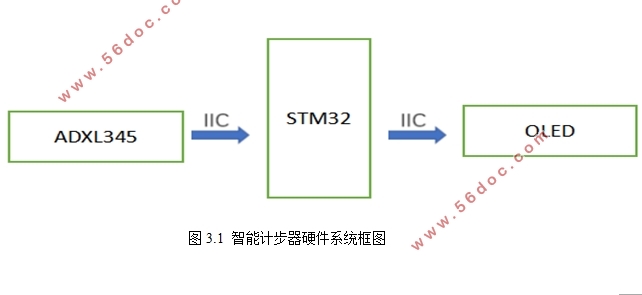基于stm32智能运动系统设计
来源:56doc.com 资料编号:5D26766 资料等级:★★★★★ %E8%B5%84%E6%96%99%E7%BC%96%E5%8F%B7%EF%BC%9A5D26766
资料以网页介绍的为准,下载后不会有水印.资料仅供学习参考之用. 密 保 惠 帮助
资料介绍
基于stm32智能运动系统设计(论文15000字)
摘要:针对目前常用的步数测量法误差和不能识别不同运动状态的问题,本文提出了一种新的智能步数测量方案,利用ADXL345三轴加速度传感器,实现偏对加速度的采样。同时通过高性能主控芯片STM32来实现数据的片上处理,将三轴加速度值进行滤波和处理。进过初步数据处理。实验结果显示,在不同的情况下测量时,该智能计步器可以识别不同的行走模式和计量出行走的步数,且测量精度在90%以上,表明了该智能计步器具有较好的精度。
关键词:计步器;stm32单片机;数据处理;高精度
Based On STM32 Intelligent Motion System Design
Abstract:Aiming at the error of common step measurement methods and the problem of inability to identify different motion states, this paper proposes a new intelligent step measurement scheme, which uses the ADXL345 triaxial acceleration sensor to achieve partial acceleration acceleration sampling. At the same time, the on-chip data processing is realized by the high-performance master chip STM32, and the triaxial acceleration values are filtered and processed. Into the preliminary data processing, after the way through Bluetooth transmission, sent to the computer PC through MATLAB for data processing and more detailed analysis. The experimental results show that the smart pedometer can identify different walking patterns and measure the number of walking steps when measured in different situations, and the measurement accuracy is above 90%, indicating that the smart pedometer has a better Accuracy.
Key words: Pedometer; data processing ;stm32 ;high-accuracy


目录
1.绪论 1
1.1研究背景 1
2 运动步数检测模型 2
2.1 人体运动模型 2
2.2 加速度的坐标系转换 3
2.3 加速度值的预处理 6
2.4 加速度数据的滤波 8
2.4.1 中值滤波器 9
2.4.2均值滤波器 10
2.4.3快速傅立叶变换 11
2.5行走步数的提取 12
2.5.1动态阈值法 12
2.5.2峰值检测法 13
2.6爬楼与计步分析 13
3硬件系统方案设计 16
3.1总体硬件系统方案设计 16
3.2 系统硬件设计 17
3.2.1 主控芯片选择 17
3.2.2 加速度传感器选择 17
3.2.3 显示模块选择 18
4 软件系统方案设计 19
4.1 数据预处理与滤波 19
4.1.1 传感器数据的预处理 19
4.1.2 滤波器的选择 20
4.3 嵌入式程序设计 21
4.2.1 主程序设计 21
4.3 数据处理与步数检测 22
4.3.1 数据处理与步数检测 22
4.3.2嵌入式步数提取与模式识别 24
5.实验结果分析 27
5.1计步器测量结果与分析 27
6.总结与展望 29
6.1总结 29
6.2展望 30
致谢 31
参考文献 32
附录1 33
|





